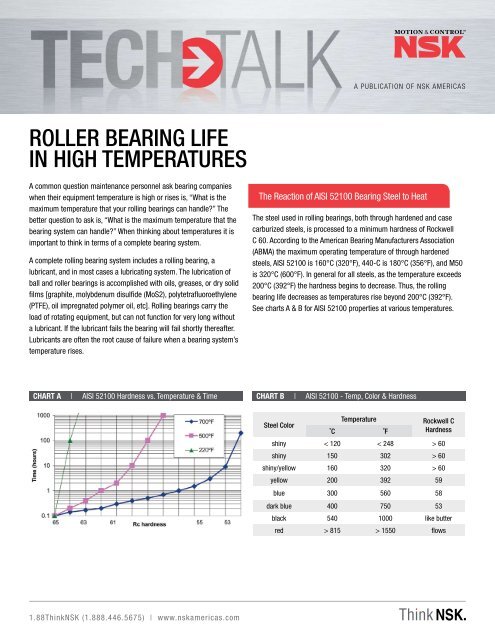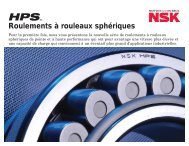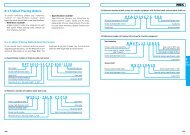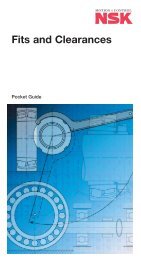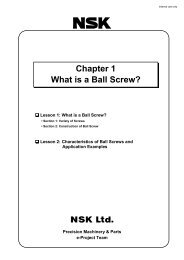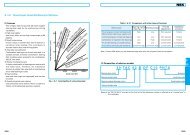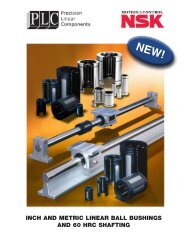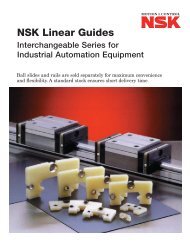Tech Talk 2: Roller Bearing Life in High Temperatures - NSK
Tech Talk 2: Roller Bearing Life in High Temperatures - NSK
Tech Talk 2: Roller Bearing Life in High Temperatures - NSK
Create successful ePaper yourself
Turn your PDF publications into a flip-book with our unique Google optimized e-Paper software.
RolleR beaR<strong>in</strong>g liFe<br />
<strong>in</strong> HigH TempeRaTuReS<br />
A common question ma<strong>in</strong>tenance personnel ask bear<strong>in</strong>g companies<br />
when their equipment temperature is high or rises is, “What is the<br />
maximum temperature that your roll<strong>in</strong>g bear<strong>in</strong>gs can handle?” The<br />
better question to ask is, “What is the maximum temperature that the<br />
bear<strong>in</strong>g system can handle?” When th<strong>in</strong>k<strong>in</strong>g about temperatures it is<br />
important to th<strong>in</strong>k <strong>in</strong> terms of a complete bear<strong>in</strong>g system.<br />
A complete roll<strong>in</strong>g bear<strong>in</strong>g system <strong>in</strong>cludes a roll<strong>in</strong>g bear<strong>in</strong>g, a<br />
lubricant, and <strong>in</strong> most cases a lubricat<strong>in</strong>g system. The lubrication of<br />
ball and roller bear<strong>in</strong>gs is accomplished with oils, greases, or dry solid<br />
films [graphite, molybdenum disulfide (MoS2), polytetrafluoroethylene<br />
(PTFE), oil impregnated polymer oil, etc]. Roll<strong>in</strong>g bear<strong>in</strong>gs carry the<br />
load of rotat<strong>in</strong>g equipment, but can not function for very long without<br />
a lubricant. If the lubricant fails the bear<strong>in</strong>g will fail shortly thereafter.<br />
Lubricants are often the root cause of failure when a bear<strong>in</strong>g system’s<br />
temperature rises.<br />
Steel Color<br />
A PUBLICATION OF <strong>NSK</strong> AMERICAS<br />
CHART A | AISI 52100 Hardness vs. Temperature & Time CHART B | AISI 52100 - Temp, Color & Hardness<br />
1.88Th<strong>in</strong>k<strong>NSK</strong> (1.888.446.5675) | www.nskamericas.com<br />
The Reaction of AISI 52100 <strong>Bear<strong>in</strong>g</strong> Steel to Heat<br />
The steel used <strong>in</strong> roll<strong>in</strong>g bear<strong>in</strong>gs, both through hardened and case<br />
carburized steels, is processed to a m<strong>in</strong>imum hardness of Rockwell<br />
C 60. Accord<strong>in</strong>g to the American <strong>Bear<strong>in</strong>g</strong> Manufacturers Association<br />
(ABMA) the maximum operat<strong>in</strong>g temperature of through hardened<br />
steels, AISI 52100 is 160°C (320°F), 440-C is 180°C (356°F), and M50<br />
is 320°C (600°F). In general for all steels, as the temperature exceeds<br />
200°C (392°F) the hardness beg<strong>in</strong>s to decrease. Thus, the roll<strong>in</strong>g<br />
bear<strong>in</strong>g life decreases as temperatures rise beyond 200°C (392°F).<br />
See charts A & B for AISI 52100 properties at various temperatures.<br />
Temperature Rockwell C<br />
Hardness<br />
˚C ˚F<br />
sh<strong>in</strong>y < 120 < 248 > 60<br />
sh<strong>in</strong>y 150 302 > 60<br />
sh<strong>in</strong>y/yellow 160 320 > 60<br />
yellow 200 392 59<br />
blue 300 560 58<br />
dark blue 400 750 53<br />
black 540 1000 like butter<br />
red > 815 > 1550 flows
Dimensional Stability vs. Temperature<br />
A PUBLICATION OF <strong>NSK</strong> AMERICAS ROLLER BEARINg LIFE IN hIgh TEMPERATURES<br />
As any metal heats up a material phase change occurs and the<br />
dimensions become unstable. In other words the bear<strong>in</strong>g parts<br />
expand. See charts C & D below for the maximum dimensionally<br />
stable temperature for various steels used <strong>in</strong> roll<strong>in</strong>g bear<strong>in</strong>gs.<br />
S<strong>in</strong>ce the most common method to measure the temperature of a<br />
bear<strong>in</strong>g is by read<strong>in</strong>g the temperature on the outside of the hous<strong>in</strong>g,<br />
it is important to remember that the temperature at the bear<strong>in</strong>g<br />
hous<strong>in</strong>g surface is 10°F to 15°F lower than bear<strong>in</strong>g temperature.<br />
Lubrication <strong>in</strong> a <strong>Bear<strong>in</strong>g</strong> System<br />
Roll<strong>in</strong>g bear<strong>in</strong>gs can’t function reliably without a lubricant. A roll<strong>in</strong>g<br />
bear<strong>in</strong>g system <strong>in</strong>cludes a roll<strong>in</strong>g bear<strong>in</strong>g, a good lubricant, and<br />
a lubricat<strong>in</strong>g system. The lubrication of ball and roller bear<strong>in</strong>gs is<br />
accomplished with oils, greases, or dry solid films. When a mach<strong>in</strong>e’s<br />
temperature rises, the ma<strong>in</strong> concern for ma<strong>in</strong>tenance personnel should<br />
not be the maximum allowable temperature the roll<strong>in</strong>g bear<strong>in</strong>g can<br />
accomodate. The ma<strong>in</strong> concern should be the maximum temperature<br />
the entire bear<strong>in</strong>g system can handle. The ma<strong>in</strong> focus should be on the<br />
maximum temperature that the lubricant and/or the lubricat<strong>in</strong>g system<br />
CHART C CHART D<br />
Designation<br />
Dimensionally Stable Temperature With Heat<br />
Treatment (HT)<br />
˚C ˚F<br />
JIS SUJ 120 248<br />
AISI 52100 120 248<br />
HTF & STF 150 302<br />
X26 150 302 HT<br />
EA - HPS 200 392<br />
S11 200 392 HT<br />
X28 200 392 HT<br />
TL 200 392 HT<br />
X29 250 482 HT<br />
<strong>NSK</strong> steel heat stabilization <strong>in</strong>fo:<br />
1) <strong>NSK</strong> standard steel (JIS SUJ) is 120 degree C (250°F) heat stabilized.<br />
2) Standard carburized steel is 120 degrees C (250°F) heat stabilized. Which part(s) are carburized<br />
are specify us<strong>in</strong>g the “g” code.<br />
3) S11 steel is 200 degrees C (392°F) heat stabilized <strong>in</strong>ner and outer r<strong>in</strong>g. <strong>Roller</strong>s are not heat stabilized.<br />
4) X28 steel is 200 degrees C (392°F) heat stabilized <strong>in</strong>ner and outer r<strong>in</strong>g. <strong>Roller</strong>s are not heat stabilized.<br />
5) X29 is 250 degrees C (482°F) but not available <strong>in</strong> all sizes.<br />
6) TL steel is 200 degrees C (392°F) heat stabilized <strong>in</strong>ner r<strong>in</strong>g unless a “g” code is specified to<br />
<strong>in</strong>dicate other parts need heat stabilization. Note with TL <strong>in</strong> the p/n the <strong>in</strong>ner would still be TL<br />
even if “g” code is used.<br />
7) HTF is 150 degrees C (302°F) heat stabilized. Which part(s) is carburized are specify us<strong>in</strong>g the “g” code.<br />
1.88Th<strong>in</strong>k<strong>NSK</strong> (1.888.446.5675) | www.nskamericas.com<br />
can endure because their failure will cause the roll<strong>in</strong>g bear<strong>in</strong>g to fail.<br />
A lubricant’s failure due to a high temperature is difficult to detect.<br />
Therefore, it is important to monitor the temperature of a lubricant.<br />
Without a good supply of oil a roll<strong>in</strong>g bear<strong>in</strong>g will fail before its potential<br />
life (L10 life) due to friction and wear between the roll<strong>in</strong>g element and<br />
the raceways. Oil between the roll<strong>in</strong>g element (ball, spherical roller,<br />
cyl<strong>in</strong>drical roller, etc.) and the raceway reduces friction and wear, and<br />
thus reduces heat generation.<br />
Oil can be supplied to a roll<strong>in</strong>g bear<strong>in</strong>g either directly or through the<br />
use of grease. Oils used to lubricate a roll<strong>in</strong>g bear<strong>in</strong>g <strong>in</strong>clude base oil<br />
and sometimes additives. Greases are made up of base oil (65-95%),<br />
thickener (3-30%), and additives (0-15%). Sometimes up to 5% of a<br />
solid lubricant is added to grease. It is the base oil <strong>in</strong> grease that does<br />
the work <strong>in</strong> a bear<strong>in</strong>g system, not the thickener, nor the additives. A<br />
thickener holds the oil and the additives improve the properties of the<br />
thickener. The oil does the work for the roll<strong>in</strong>g bear<strong>in</strong>g, the thickener<br />
keeps the oil <strong>in</strong> place, and the additive can enhance the performance<br />
of the oil and/or thickener.<br />
Whether oil or grease is used to lubricate a roll<strong>in</strong>g bear<strong>in</strong>g, both can<br />
only endure so much heat before they lose their effectiveness <strong>in</strong> the<br />
bear<strong>in</strong>g system. Chart E shows maximum temperatures of various oils.<br />
2
CHART E<br />
oil Type<br />
Max. temp. for oil<br />
sump lubrication<br />
Max. temp. for<br />
circulat<strong>in</strong>g oil<br />
lubrication<br />
Viscosity at 40ºC<br />
(cSt, mm 2 /s)<br />
Suitability for<br />
high temp.<br />
(=150ºC, 302ºF)<br />
* Depend<strong>in</strong>g on the oil type.<br />
A PUBLICATION OF <strong>NSK</strong> AMERICAS ROLLER BEARINg LIFE IN hIgh TEMPERATURES<br />
m<strong>in</strong>eral oil (pao)<br />
polyalphaolef<strong>in</strong><br />
(water <strong>in</strong>soluable)<br />
1.88Th<strong>in</strong>k<strong>NSK</strong> (1.888.446.5675) | www.nskamericas.com<br />
polyglycol ester Silicone oil alkoxy fluoro oil<br />
˚C ˚F ˚C ˚F ˚C ˚F ˚C ˚F ˚C ˚F ˚C ˚F<br />
100 212 150 302<br />
150 302 200 392<br />
100 to<br />
150<br />
150 to<br />
200<br />
212 to<br />
302<br />
302 to<br />
392<br />
Thickener Type base oil Soap<br />
Normal<br />
Complex<br />
Bentonites<br />
Polyurea<br />
PTFE or FEP<br />
150 302<br />
m<strong>in</strong>eral oil<br />
150 to<br />
200<br />
302 to<br />
392<br />
alum<strong>in</strong>um<br />
calcium<br />
lithium<br />
sodium<br />
150 to<br />
220<br />
max. Temperature<br />
˚C ˚F<br />
70<br />
50<br />
130<br />
100<br />
302 to<br />
428<br />
200 392 250 482 240 464<br />
2 to 4500 15 to 1500 20 to 2000 7 to 4000 4 to 100,000 20 to 650<br />
moderate good moderate to good* good* very good very good<br />
The type and amount of thicken<strong>in</strong>g agent used (organic, <strong>in</strong>organic,<br />
metal soap) and the base oil type (m<strong>in</strong>eral or synthetic oil) and its<br />
viscosity determ<strong>in</strong>e the upper and lower operat<strong>in</strong>g temperature<br />
limits of lubricat<strong>in</strong>g greases. Charts F, G & H show the maximum<br />
temperatures of greases by thickener, base oil, and soap, and a<br />
comparison of thickeners.<br />
CHART G | Thickener Comparison<br />
Thickner<br />
application Temperature With Heat Treatment (HT)<br />
˚C ˚F ˚C ˚F<br />
Lithium 120 to 140 250 to 285 175 to 205 350 to 400<br />
Calcium up to 80 175 90 to 110 195 to 230<br />
Alum<strong>in</strong>um 70 to 80 160 to 175 110 to 120 230 to 250<br />
Sodium 120 250 160 to 180 320 to 355<br />
Alum<strong>in</strong>um<br />
complex<br />
up to 180 up to 355 250 480<br />
Bentonite 180 355 250 480<br />
Polyureas 180 355 220 to 270 430 to 520<br />
CHART F | Grease Comparison<br />
158<br />
122<br />
266<br />
212<br />
PAO lithium 150 302<br />
ester lithium 130 266<br />
alum<strong>in</strong>um 160 320<br />
barium 140 284<br />
m<strong>in</strong>eral oil calcium 140 284<br />
lithium 150 302<br />
sodium 130 266<br />
alum<strong>in</strong>um 160 320<br />
PAO<br />
barium<br />
calcium<br />
160<br />
160<br />
320<br />
320<br />
lithium 180 356<br />
barium 130 266<br />
ester calcium 130 266<br />
lithium 180 356<br />
silicone oil lithium 180 356<br />
m<strong>in</strong>eral oil 150 302<br />
PAO 180 356<br />
m<strong>in</strong>eral oil 160 320<br />
PAO 200 392<br />
silicone oil 200 392<br />
fluorosilicone oil 200 392<br />
alkoxyfluoro oil 250 482<br />
fluorosilicone oil 200 392<br />
3
A PUBLICATION OF <strong>NSK</strong> AMERICAS ROLLER BEARINg LIFE IN hIgh TEMPERATURES<br />
The chart below gives temperature ranges of solid lubricants.<br />
CHART H<br />
Solid<br />
lubricant<br />
<strong>in</strong> air <strong>in</strong> Vacuum<br />
˚C ˚F ˚C ˚F<br />
m<strong>in</strong>. max m<strong>in</strong>. max m<strong>in</strong>. max m<strong>in</strong>. max<br />
Graphite 50 550 122 1022 n/a n/a n/a n/a<br />
Molybdenum<br />
disulfide<br />
Tungsten<br />
disulfide<br />
-100 320 -148 608 -100 650 -148 1202<br />
-100 410 -148 770 -100 750 -148 1382<br />
Gold -100 200 -148 392 -100 200 -148 392<br />
Silver -100 100 -148 212 -100 600 -148 1112<br />
Lead -100 210 -148 410 -100 400 -148 752<br />
Flurores<strong>in</strong>s -250 200 -418 392 -250 250 -418 482<br />
Oil Viscosity and Temperature<br />
Another th<strong>in</strong>g to consider with high temperatures <strong>in</strong> a bear<strong>in</strong>g system<br />
is the oil’s viscosity. Viscosity is the measure of the relative resistance<br />
of a fluid to flow at a given temperature. The higher the viscosity, the<br />
greater its resistance to flow. Viscosity is measured either <strong>in</strong> centistokes<br />
(cSt) or SUS (Saybolt Universal Seconas). With greases the viscosity<br />
number is the flow rate of the base oil, not the thickener.<br />
A viscosity of a lubricant should be sufficient to separate parts under<br />
operat<strong>in</strong>g conditions, but not so high that extra drag is created.<br />
As the temperature rises the viscosity of oils lowers. The higher the<br />
temperature, the higher the viscosity needed <strong>in</strong> a bear<strong>in</strong>g system.<br />
Viscosity Index is the measurement of the rate of change of viscosity<br />
with temperature. The higher the viscosity <strong>in</strong>dex, the more gradual the<br />
rate of change. See chart I.<br />
Generally <strong>in</strong> high temperature applications, if the oil or grease used has<br />
a lower viscosity, the bear<strong>in</strong>g system will fail prematurely. As can be<br />
expected, generally <strong>in</strong> a high temperature application a higher viscosity<br />
oil or grease should be used. See chart J for oil viscosity vs. temperature<br />
for various oils.<br />
Temperature Impact on the <strong>Life</strong> of Oil<br />
The most important property of oil, from a quality standpo<strong>in</strong>t, is its<br />
chemical or oxidation stability. Heat is primarily an accelerator of oil<br />
oxidation. The rate of any chemical reaction, <strong>in</strong>clud<strong>in</strong>g the oxidation of<br />
hydrocarbons will double for every 18°F (10°C) <strong>in</strong>crease <strong>in</strong> temperature.<br />
It is estimated that the life of an oil is decreased 50% for every 18°F<br />
1.88Th<strong>in</strong>k<strong>NSK</strong> (1.888.446.5675) | www.nskamericas.com<br />
(10°C) temperature rise above 140°F (60°C). At temperatures greater<br />
than 248°F (120°C) oxidation greatly affects grease life. The formula<br />
for this would be:<br />
Lt = _ * L<br />
where:<br />
Lt = Oil life due to temperature greater than 60°C (140°F)<br />
_ = Temperature life factor<br />
L = Expected life of oil at or below 60°C (140°F)<br />
CHART I | The Rate of Change of an Oil’s Viscosity with Temperature<br />
CHART J<br />
CHART K<br />
Viscosity Index is the measurement of the rate of<br />
chage of viscosity with temperature<br />
4
A PUBLICATION OF <strong>NSK</strong> AMERICAS ROLLER BEARINg LIFE IN hIgh TEMPERATURES<br />
CHART L CHART M | Grease Lubrication Intervals (Weeks) for Ball <strong>Bear<strong>in</strong>g</strong>s<br />
Lubrication System Considerations<br />
No matter what is used to lubricate a roll<strong>in</strong>g bear<strong>in</strong>g <strong>in</strong> a high<br />
temperature application and/or environment, the lubrication system<br />
can either extend the life of a roll<strong>in</strong>g bear<strong>in</strong>g or decrease it. A bear<strong>in</strong>g<br />
system must be designed to assist the bear<strong>in</strong>g <strong>in</strong> meet<strong>in</strong>g its potential<br />
life. Attention to the lubrication system should never be overlooked<br />
or ignored.<br />
Several oil systems can be used to remove heat from a bear<strong>in</strong>g system.<br />
Grease and dry solid film do not assist <strong>in</strong> remov<strong>in</strong>g heat from a roll<strong>in</strong>g<br />
bear<strong>in</strong>g. The primary consideration with greases is the relubrication<br />
method and <strong>in</strong>terval.<br />
In the higher speed ranges of operation, too much grease will cause<br />
overheat<strong>in</strong>g. The amount of grease which is appropriate for a particular<br />
high speed application can only be determ<strong>in</strong>ed by experience. In<br />
general, about half to a third of the open area <strong>in</strong> a bear<strong>in</strong>g should be<br />
filled with grease on start up. If excess grease <strong>in</strong> the bear<strong>in</strong>g causes<br />
overheat<strong>in</strong>g, it will be necessary to remove some grease from the<br />
bear<strong>in</strong>g. A slight show of purged grease at the bear<strong>in</strong>g seals is normal<br />
and also helps keep contam<strong>in</strong>ants out of the bear<strong>in</strong>g. More grease can<br />
be tolerated and is generally desirable <strong>in</strong> low speed applications.<br />
When establish<strong>in</strong>g grease re-lubrication schedules, a small amount<br />
of grease at frequent <strong>in</strong>tervals is preferable to large quantities at<br />
<strong>in</strong>frequent <strong>in</strong>tervals. Tables M, N, O & P can be used to determ<strong>in</strong>e<br />
lubrication <strong>in</strong>tervals.<br />
1.88Th<strong>in</strong>k<strong>NSK</strong> (1.888.446.5675) | www.nskamericas.com<br />
bear<strong>in</strong>g<br />
bore (<strong>in</strong>)<br />
operat<strong>in</strong>g Speed (rpm)<br />
250 500 1000 2000 3000<br />
1 * * 130 70 40<br />
2 * 160 70 35 20<br />
3 * 150 65 23 9<br />
4 * 100 40 13 4<br />
CHART N | Grease Lubrication Intervals (Weeks) for Ball<br />
<strong>Bear<strong>in</strong>g</strong>s Motors<br />
motor Duty<br />
24 hr/day, 7 days/wk,<br />
Clean, Max. amb. Temp. = 100ºF<br />
24 hr/day, 7 days/wk,<br />
Poor conditions: hot, dry, or humid<br />
16 hr/day, 5 days/wk,<br />
Clean, Max. amb. Temp. = 100ºF<br />
16 hr/day, 5 days/wk,<br />
Poor conditions: hot, dry, or humid<br />
Hours Run<br />
per Day<br />
motor Horsepower<br />
0.5 to 7.5 10 to 40 50 to 150<br />
72 48 36<br />
36 16 16<br />
144 96 72<br />
72 52 36<br />
CHART O | Grease Lubrication Intervals (Weeks) for<br />
Spherical <strong>Roller</strong> <strong>Bear<strong>in</strong>g</strong>s<br />
bear<strong>in</strong>g Speed (rpm)<br />
250 500 750 1000 1500 2000 3000<br />
8 12 12 10 7 5 4 3<br />
16 12 7 5 4 2 2 1<br />
24 10 5 3 2 1 1 1<br />
CHART P | Grease Lubrication Intervals (Weeks) Spherical<br />
<strong>Roller</strong> <strong>Bear<strong>in</strong>g</strong> Temp. and Conditions<br />
operat<strong>in</strong>g<br />
Conditions<br />
Clean<br />
Dirty<br />
bear<strong>in</strong>g <strong>Temperatures</strong> grease<br />
<strong>in</strong>terval<br />
ºC ºF<br />
0 to 49<br />
49 to 65<br />
65 to 93<br />
0 to 65<br />
65 to 93<br />
32 to 120<br />
120 to 150<br />
150 to 200<br />
32 to 150<br />
150 to 200<br />
24 to 40<br />
4 to 12<br />
1 to 4<br />
1 to 4<br />
< 1<br />
Moisture 0 to 93 32 to 200 < 1<br />
5
A PUBLICATION OF <strong>NSK</strong> AMERICAS ROLLER BEARINg LIFE IN hIgh TEMPERATURES<br />
There are several lubrication systems when it comes to oil; sump<br />
(bath), circulation through sump, circulation through sump with cool<strong>in</strong>g,<br />
jet (<strong>in</strong>jection) <strong>in</strong>to bear<strong>in</strong>g, comb<strong>in</strong>ation of bypass circulation with cool<strong>in</strong>g<br />
and jet, and mist (spot). An oil bath system can be used to lubricate a<br />
bear<strong>in</strong>g, but <strong>in</strong> general, it does not assist <strong>in</strong> remov<strong>in</strong>g the heat from a<br />
bear<strong>in</strong>g system. The oil level for a sump bear<strong>in</strong>g should come up to the<br />
middle of the roll<strong>in</strong>g element when it is at it’s lowest position.<br />
The oil flow rate for a circulat<strong>in</strong>g oil system can only be determ<strong>in</strong>ed by<br />
experience. For a steel mill’s cont<strong>in</strong>uous cast<strong>in</strong>g mach<strong>in</strong>e the follow<strong>in</strong>g<br />
formula can be used:<br />
Fccm = 0.00003 (OD) (W) where:<br />
Fccm = Oil Flow Rate for a Cont<strong>in</strong>uous<br />
Cast<strong>in</strong>g Mach<strong>in</strong>e (cc/hr/bear<strong>in</strong>g)<br />
OD = <strong>Bear<strong>in</strong>g</strong> Outside Diameter (mm)<br />
W = <strong>Bear<strong>in</strong>g</strong> Width (mm)<br />
Note: If the result is less then one, then one should be used.<br />
For a paper mach<strong>in</strong>e’s dryer section charts Q & R can be used.<br />
(Note: Oil flow rates are per bear<strong>in</strong>g on drive side of mach<strong>in</strong>e. Except<br />
where condensate and blow through steam is removed through<br />
operat<strong>in</strong>g (tend<strong>in</strong>g) side journal, flow rate for front bear<strong>in</strong>g is 60-75%<br />
of these values.)<br />
Conclusion<br />
A complete roll<strong>in</strong>g bear<strong>in</strong>g system <strong>in</strong>cludes a roll<strong>in</strong>g bear<strong>in</strong>g, a<br />
lubricant, and <strong>in</strong> most cases a lubricat<strong>in</strong>g system. The lubrication of<br />
ball and roller bear<strong>in</strong>gs is accomplished with oils, greases, or dry solid<br />
films. Roll<strong>in</strong>g bear<strong>in</strong>gs carry the load of rotat<strong>in</strong>g equipment, but can<br />
not function for very long without a lubricant. If the lubricant fails the<br />
bear<strong>in</strong>g will fail shortly thereafter. Lubricants are often the root cause<br />
of failure when a bear<strong>in</strong>g system’s temperature rises. Therefore if your<br />
equipment temperature is high or rises consider what is happen<strong>in</strong>g to<br />
the entire bear<strong>in</strong>g system, not just the bear<strong>in</strong>g.<br />
1.88Th<strong>in</strong>k<strong>NSK</strong> (1.888.446.5675) | www.nskamericas.com<br />
CHART Q | Paper Mach<strong>in</strong>e Dryer <strong>Bear<strong>in</strong>g</strong> Lubrication<br />
bear<strong>in</strong>g<br />
bore (mm)<br />
SaTuRaTeD STeam<br />
pReSSuRe<br />
psl<br />
50-100 psi<br />
(345-690 kpa)<br />
oil FloW RaTe (p<strong>in</strong>TS/m<strong>in</strong>uTe)<br />
kgs/sq.<br />
meter<br />
101-125 psi<br />
(600-862 kpa)<br />
Steam pressure<br />
126-150 psi<br />
(862-1034 kpa)<br />
CoRReSponD<strong>in</strong>g STeam<br />
TempeRaTuRe<br />
ºF ºC<br />
over 150 psi<br />
(over 1034 kpa)<br />
< 190 3 4 6 8<br />
191-260 3-4 4-6 6-8 8-10<br />
261-349 4-5 6-7 8-9 10-11<br />
350-500 16 24 26 28<br />
> 500 24-32 40 48 56<br />
Oil flow rates are per bear<strong>in</strong>g on drive side of mach<strong>in</strong>e. Except where condensate and<br />
blow-through steam is removed through operat<strong>in</strong>g (tend<strong>in</strong>g) side journal, flow rate for front<br />
bear<strong>in</strong>g is 60-75% of these values.<br />
CHART R<br />
50 35 150 281 138<br />
60 42 200 293 145<br />
75 52 750 308 153<br />
100 70 300 327 164<br />
125 87 900 344 173<br />
150 150 500 358 181<br />
The <strong>in</strong>formation <strong>in</strong> this article is not presented as a help <strong>in</strong> choos<strong>in</strong>g a bear<strong>in</strong>g and/or a lubricant<br />
for a mach<strong>in</strong>e. Rather, this article is designed to help ma<strong>in</strong>tenance personal th<strong>in</strong>k of maximum<br />
temperatures that a bear<strong>in</strong>g system can endure under use, rather than th<strong>in</strong>k of temperatures <strong>in</strong><br />
relation to only a bear<strong>in</strong>g, only the lubricant, and only the lubricant system.<br />
For more <strong>in</strong>formation, please contact nSK at 1.88Th<strong>in</strong>k<strong>NSK</strong><br />
(1.888.446.5675) or visit www.nskamericas.com<br />
6


